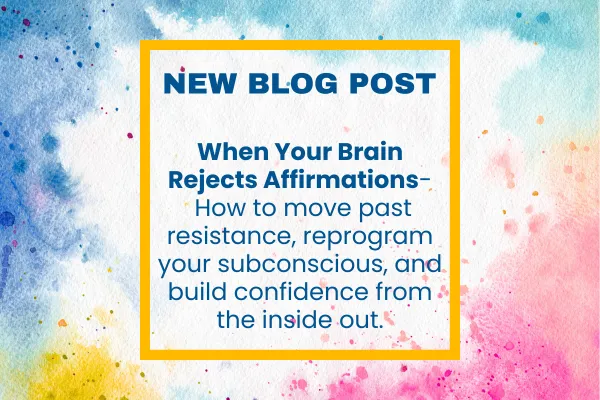
When Your Brain Rejects Affirmations
🌿When Your Brain Rejects Affirmations
You whisper the words every morning:
“I am enough.”
But before the sentence even lands, a quiet voice answers back—“No, you’re not.”
That moment right there is where most women give up on self-affirmations. We assume that inner resistance means we’ve failed. In reality, it means your subconscious is protecting you.
Why Affirmations Feel Fake

Affirmations don’t stick when they clash with deep-rooted beliefs formed through years of self-criticism, rejection, or impossible standards.
When you repeat a statement your body doesn’t believe, your nervous system actually tightens—it perceives a threat to its sense of truth.
This is why saying “I am confident” can trigger anxiety instead of empowerment. Your brain is trying to reconcile a new belief with an old identity.
And that's ok.
It's ok to feel uncomfortable. And, in fact, the discomfort you're feeling is a sign that the affirmation is perfect for you! But if it feels too hard, rather than giving up, try this--
The Real First Step
Instead of forcing new words, start by meeting the resistance with curiosity.
Ask yourself:
When did I first learn to doubt my worth?
Whose voice am I really hearing when I say “I’m not enough”?
Awareness turns affirmation into transformation. Once you witness the old pattern, it begins to lose power. Commit to at least 15-20 minutes each day for 1 week to contemplate these questions and journal your findings.
A Softer Reframe

Replace rigid affirmations with bridge statements—gentle truths your mind can believe right now.
Try these:
“I’m learning to trust myself more each day.”
“I’m open to the possibility that I’m enough.”
“It’s becoming easier to speak kindly to myself.”
These phrases work because they honor both parts of you—the one that wants to grow and the one that still needs safety.
And here’s something important to remember:
It’s supposed to feel uncomfortable.
If your affirmation doesn’t feel completely believable at first, that’s a good sign—it means you’re stretching into new territory.
Say it anyway.
Speak it with conviction, as if there’s a quiet fire in your belly fueling every word.
When you pair your declaration with emotion, you activate your subconscious on a deeper level—your body begins to feel what your mind can’t yet fully believe.
That’s how change begins to take root.
Integrate It in the Body
Confidence doesn’t live in your mind — it lives in your body.
Each thought, word, and emotion carries an energetic imprint, and over time those imprints form patterns in the subconscious.
To begin reshaping those patterns, set aside three quiet minutes every morning to repeat your chosen bridge affirmation.
Stand or sit with your spine tall, take a few grounding breaths, and place one hand over your heart.
As you speak the words slowly, feel them resonate in your body.
At first, it may feel uncomfortable or even untrue.
That’s normal — you’re introducing a new language to a part of you that’s only ever known self-criticism.
But every repetition is like tracing a new neural pathway, carving a gentle groove into your subconscious.
And with consistency, those grooves deepen into a new default pattern — one that begins to hold you in safety and self-trust.
Over time, you’ll notice something magical.
You’ll catch yourself living the affirmation instead of saying it.
For example, if your affirmation is “I’m learning to trust myself,”
you might one day realize you made a decision without second-guessing it —
and it felt peaceful instead of terrifying.
That’s the moment you know: the affirmation has become a belief.
You no longer need to repeat it every morning because it’s already integrated — it’s who you are.
If you ever feel yourself slipping back into old patterns of doubt or insecurity, simply bring that affirmation back into your routine for a couple of weeks.
Think of it like muscle memory — the practice re-activates the pattern of self-trust that’s already been established.
Affirmations are not about forcing belief; they’re about training your mind and body to remember what’s true.
Each repetition is a brushstroke painting a new identity — one rooted in calm, confidence, and worthiness.
Closing Reflection
Affirmations don’t fail because you’re broken.
They fail because you’re healing.
Your mind isn’t rejecting change—it’s asking to be included in it.
✨ Today’s Practice:
Pick one bridge statement. Say it aloud three times. Breathe after each one. Notice how your body responds. That’s where real confidence begins.
Cindy has helped countless women reprogram limiting beliefs and rebuild self-trust using personalized affirmations as part of her transformational coaching process.
If you’ve been struggling with self-doubt, negative self-talk, or feeling “not enough,” it’s time to change the conversation within.
✨ Book a private coaching session with Cindy and receive your own custom affirmation—crafted specifically around your current challenge—to help you repattern your thoughts and reconnect to your inner power.
Begin your journey toward a calmer mind, deeper confidence, and a more fulfilling life today. 💛
📍 Serving women locally in Charlotte, NC and globally online
